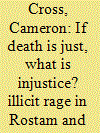|
|
|
Sort Order |
|
|
|
Items / Page
|
|
|
|
|
|
|
| Srl | Item |
| 1 |
ID:
137390


|
|
|
|
|
| Summary/Abstract |
This is a comparative study of anger and narrative control in two tragic stories cast in an epic-heroic register, the “Tale of Rostam and Sohrab” of Ferdowsi's Shahnameh and “The Knight's Tale” of Chaucer's Canterbury Tales. The narrators of both stories are heavily invested in upholding a certain normative interpretation of the events they recount, a fatalistic worldview that justifies itself through the necessarily agnostic optimism that these senseless catastrophes gain meaning when situated within a greater order that is beyond the capacity of man to comprehend. The emotional responses of outrage and grief therefore have no legitimate place in this worldview, and must be submitted to a process of rationalization and violent suppression in order to be kept in check. However, this same process also reveals the underlying aporias of its own normative logic, producing a subtextual counter-narrative that resists and undermines the dominant voice of the text. The resulting fragmentation and narrative collapse provides a fruitful opportunity to investigate how both texts respond to a crucial ontological topic in medieval literature and philosophy: what does it mean to be an autonomous subject within a divinely ordered universe, and how can one distinguish justice from tyranny in a world entirely governed by fate?
|
|
|
|
|
|
|
|
|
|
|
|
|
|
|
|
| 2 |
ID:
160285


|
|
|
|
|
| Summary/Abstract |
This article is a review of the afterlife, or Nachleben, of the romance Vis and Rāmin, one of the first representatives of its genre in New Persian literature. In addition to providing readers with an extensive bibliography of sources and research concerning the poem, it also analyzes these materials to put forward two basic arguments: one, that moral or religious antipathy to the poem’s contents may not have played as great a role in its fortunes as did aesthetic taste; and two, that V&R proved to be a more widely circulated and durable work than is commonly supposed, but on the level of fragments, not the entire text. In light of these arguments, it is proposed that studies structured around the comparison of fragments—themes, ideas, ethics, and motifs, rather than whole texts—may offer more purchase in constructing models of analysis that situate V&R, and Persian literature more broadly, within a literary oikumene in which it connects and interacts with neighboring traditions.
|
|
|
|
|
|
|
|
|
|
|
|
|
|
|
|
|
|
|
|
|